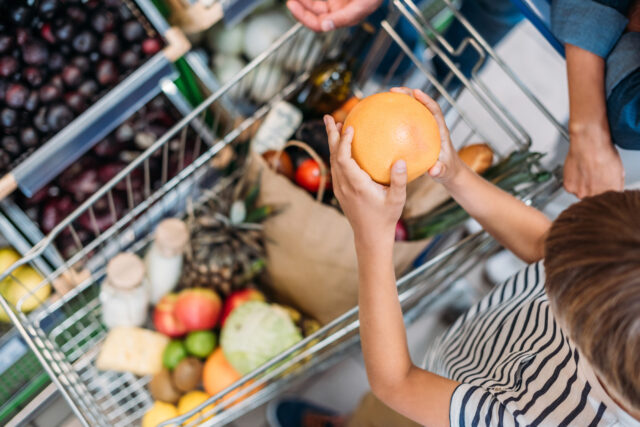During the COVID-19 pandemic, federal action boosted food assistance for low-income families enrolled in CalFresh, the state version of the federal Supplemental Nutrition Assistance Program (SNAP). Starting in March 2020, emergency allotments increased benefits up to the maximum amount for eligible households (about $194 for a one-person household) but bypassed nearly 40 percent of households with incomes so low they already received the maximum. In April 2021, the policy was revised to provide a boost of at least $95 to the lowest-income families.
Average CalFresh benefits doubled over about three years of the pandemic, including temporary and permanent benefit expansions beyond emergency allotments. But prices for goods and services also continued to rise, so that, adjusted for inflation, CalFresh benefits increased 77 percent.
Which CalFresh households received emergency allotments at the start of the pandemic?
The March 2020 emergency allotments gave more assistance to households that had more resources beyond CalFresh from earned income, unemployment insurance, or cash assistance programs. Households with current or recent earnings were about equally represented in the groups that received different sizes of allotments: 27 percent of those with a large allotment had earnings, as did 32 percent of those with a small allotment and 25 percent of those with no allotment.
Cash assistance was more common among households with a boost in March 2020 than those without
% with income source

SOURCE: Authors’ analysis of Monthly Medi-Cal Eligibility Data System Eligibility Files (MEDS MEF), Electronic Benefits Transfer (EBT) / Statewide Automated Reconciliation Systems (SARS), and Employment Development Department base wage file data.
NOTES: Chart shows share of households with income from each source, among those with no, small, or large changes in CalFresh benefits between February and March 2020. “Large” increase means benefit in February was <20 percent of maximum; “Small” means it was at least 20 percent of maximum. SSI/SSP and CalWORKs income refer to February 2020, and “current or recent earnings” refers to the 18 months before the pandemic. SSI/SSP is Supplementary Security Income/Supplementary Security Payment.
Were higher CalFresh benefits a factor in people’s decisions about employment?
Households that received a boost in March 2020 saw no related changes in employment or earnings; this boost likely did not incentivize CalFresh recipients to leave the labor market at a time when many low-paid workers lost jobs as businesses shuttered, and the spread of COVID-19 threatened those who continued to work in person. March emergency allotments represented a small share of earnings for this group: at the median, those employed at the time saw an allotment worth up to 12 percent of their monthly earnings.
National evidence shows that participating in SNAP does not discourage work, and this is supported by examining California’s rollout of emergency allotments in CalFresh. Evidence is mixed, however, for those who received small increases in April 2021; some may have had short-term declines in work. Earnings were lower just after the April change, suggesting reduced hours or short periods without work; furthermore, April was a small boost, worth at most 6 percent of monthly earnings.
Did emergency allotments encourage people to keep benefits when they were eligible?
Those who received a March 2020 boost tended to stay enrolled on CalFresh while they were eligible; they also returned quickly to the program if they did not document their eligibility in time. About 8 to 15 months after the March 2020 allotment, CalFresh participation was 11 to 14 percentage points higher for households that saw the boost than for those that did not. The estimates are larger for households without children, suggesting that adult-only CalFresh households might be particularly motivated by higher benefits to complete the steps necessary to stay enrolled in CalFresh.
Households with fewer resources—who received the second boost—did not respond as strongly. For the April 2021 allotment, continued participation fell by a small but statistically significant amount (1 to 2 percentage points).
These results suggest that higher benefits outweighed some of the challenges that, in normal times, lead people to exit CalFresh when they are still eligible. Yet the small increase in April 2021 for the lowest-income participants did not lead to a similar incentive to requalify with CalFresh, suggesting that these households may face a heavier burden around documenting their eligibility.
What insights can pandemic emergency allotments offer for crafting future CalFresh policy?
When the federal government first designed pandemic increases to SNAP, it provided no relief to the lowest-income households. Inclusive designs in future crises could increase benefits for all households by a percentage, or focus the largest increases on households with the lowest cash incomes.
State policymakers can ensure CalFresh meets its goals by maximizing dollars drawn down from the federal government and by considering targeted state funding. Emergency allotments revealed that households enrolled in CalFresh and other safety net programs receive lower CalFresh benefits than those with earned income, despite being enrolled because they face barriers to earning sustaining incomes. Other ways policymakers might help households meet basic needs include ensuring eligible expenses are deducted so individuals receive their full CalFresh benefits, seeking waivers to federal requirements, offering state-funded supplements to CalFresh, and boosting benefits in other programs.
Topics
COVID-19 Health & Safety Net Poverty & Inequality




